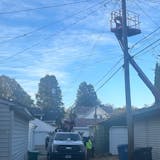St. Paul teachers returned to work Friday afternoon after a three-day strike that disrupted lives and sent thousands marching in the streets.
The teachers union and the school district announced a deal about 4 a.m. Friday, a day after resuming talks at the urging of Gov. Tim Walz. Classes are scheduled to resume on Monday.
At Central High School, cars filled the parking lot as teachers returned to work, and red-and-white picket signs were stuffed into a nearby garbage can. Inside the school, refreshments piled up by the entrance and teachers wearing red cheerfully greeted one another.
Several teachers said they were happy to return to the building, despite not knowing exactly what the union had agreed to.
"I guess I don't feel like it's over," said Brian Knox, who teaches music production. "I think we only started making the point we were trying to make."
Nick Faber, president of the St. Paul Federation of Educators (SPFE), said at a news conference Friday that the union negotiated "some great tentative agreements that we're proud of," including wage increases and more staff. But he emphasized that teachers were prepared to stay on the picket lines and that they will continue organizing.
"I want to be clear," he said. "The only thing that was able to stop them and slow them down was a global pandemic."
At district headquarters, School Board Chairwoman Marny Xiong called the past couple of days "painful and exhausting for our community," and Superintendent Joe Gothard apologized to students and families.


